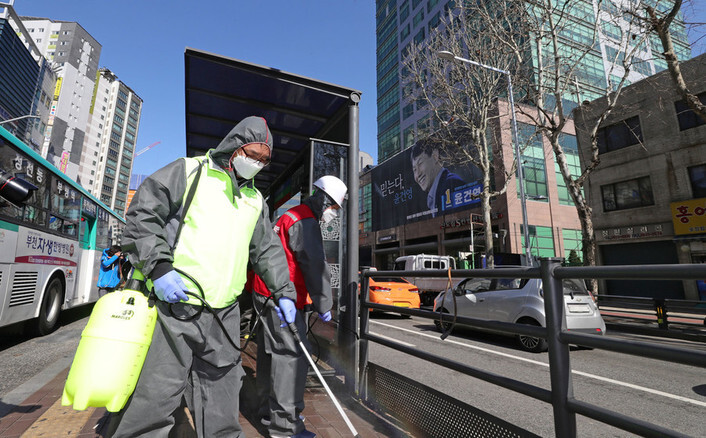hankyoreh
Links to other country sites 다른 나라 사이트 링크
Government decides not to disclose personal information about novel coronavirus patients

After the South Korean government’s disclosure of the movement of people infected with COVID-19, the disease resulting from the novel coronavirus, provoked criticism about the violation of their privacy, the public health authorities have decided not to disclose any information that could identify them, such as details about their address or the name of their workplace.
The Korean Centers for Disease Control and Prevention (KCDC) said on Mar. 14 that it had recently given local governments a new set of guidelines for announcing the movement of COVID-19 patients that incorporate recommendations from the National Human Rights Commission of Korea (NHRCK). The new guidelines ask local governments not to release specific addresses or workplace names so as to protect patients’ privacy. Local governments are also being asked to stop disclosing patients’ travel path and the places they’ve visited.
According to the guidelines, the places visited and means of transportation will only be disclosed when there are concerns that other people may have made contact with the patient and been infected in light of the patient’s symptoms, their use of a mask, the time they were at the location and the type and period of exposure. The information that will be disclosed in such cases includes the floor and unit number in the building, the name of the business and timeframe, the street address, the number of the mass transit line and vehicle number, the time and place when the patient boarded, and the time and place when they disembarked.
The guidelines also state that a patient’s movements need not be disclosed when all the people they came into contact with at the places they visited have been identified by epidemiological researchers. The period of disclosure ranges from the day before symptoms occurred until the day they were quarantined; in the case of patients who didn’t exhibit symptoms in the epidemiological survey, this period will run from the day before a sample was taken until the day of quarantine.
Along with the goal of protecting human rights, the revised guidelines for disclosing patients’ movements are linked to the need for “selectivity and concentration” in epidemiological research and managing the people who’ve come into contact with patients. Unlike the early stage of the COVID-19 outbreak, small-scale transmission clusters are now occurring sporadically, which means that it’s more efficient to prioritize resources on high-risk situations.
Much of this priority will fall on families. “We’ve seen high infectivity among family members, roommates, and friends [of patients], but there haven’t been many cases of exposure in movie theaters, for example,” said KCDC Director Jung Eun-kyeong in the briefing on Mar. 11. Jung explained that quarantining family members and others who were likely to have had close contact with patients was more important than using security cameras to track patients’ movements through public facilities. In China, researchers have found that 65-75% of secondary transmissions occurred among family members.
By Seon Dam-eun, staff reporter
Please direct comments or questions to [english@hani.co.kr]

Editorial・opinion
![[Column] Park Geun-hye déjà vu in Yoon Suk-yeol [Column] Park Geun-hye déjà vu in Yoon Suk-yeol](https://flexible.img.hani.co.kr/flexible/normal/500/300/imgdb/original/2024/0424/651713945113788.jpg) [Column] Park Geun-hye déjà vu in Yoon Suk-yeol
[Column] Park Geun-hye déjà vu in Yoon Suk-yeol![[Editorial] New weight of N. Korea’s nuclear threats makes dialogue all the more urgent [Editorial] New weight of N. Korea’s nuclear threats makes dialogue all the more urgent](https://flexible.img.hani.co.kr/flexible/normal/500/300/imgdb/original/2024/0424/7317139454662664.jpg) [Editorial] New weight of N. Korea’s nuclear threats makes dialogue all the more urgent
[Editorial] New weight of N. Korea’s nuclear threats makes dialogue all the more urgent- [Guest essay] The real reason Korea’s new right wants to dub Rhee a founding father
- [Column] ‘Choson’: Is it time we start referring to N. Korea in its own terms?
- [Editorial] Japan’s rewriting of history with Korea has gone too far
- [Column] The president’s questionable capacity for dialogue
- [Column] Are chaebol firms just pizza pies for families to divvy up as they please?
- [Column] Has Korea, too, crossed the Rubicon on China?
- [Correspondent’s column] In Japan’s alliance with US, echoes of its past alliances with UK
- [Editorial] Does Yoon think the Korean public is wrong?
Most viewed articles
- 1[Column] Park Geun-hye déjà vu in Yoon Suk-yeol
- 2N. Korean hackers breached 10 defense contractors in South for months, police say
- 3Thursday to mark start of resignations by senior doctors amid standoff with government
- 4[Editorial] New weight of N. Korea’s nuclear threats makes dialogue all the more urgent
- 5Kim Jong-un expressed ‘satisfaction’ with nuclear counterstrike drill directed at South
- 6Will NewJeans end up collateral damage in internal feud at K-pop juggernaut Hybe?
- 7[Editorial] Japan’s rewriting of history with Korea has gone too far
- 8[Cine feature] A new shift in the Korean film investment and distribution market
- 9[Column] ‘Choson’: Is it time we start referring to N. Korea in its own terms?
- 10[Column] The clock is ticking for Korea’s first lady